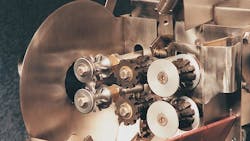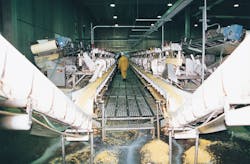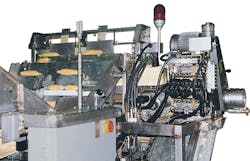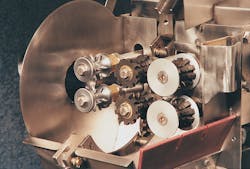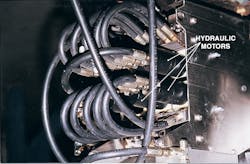Corn Processing Hits New Speeds With Hydraulics
This file type includes high resolution graphics and schematics when applicable.
Ron Anderson and Tom Kessler, co-founders of A&K Development Co., Eugene, Oreg., had plenty of ambition when they formed their company. Both had experience in the food processing industry and many ideas about incorporating hydraulics into a new generation of corn processing machines. With the assistance of a local fluid power distributor, their ideas became reality.
Sweet Corn Processing
After it has been harvested, sweet corn is brought to a food processing plant and dumped down a chute to corn huskers. As the ears move down the face of the husker, dozens of rubberized rollers rip the husk away. All of the husk is gone by the time the ears reach the bottom of the husker, where they are conveyed to the next step in production.
From a series of conveyors, the ears reach an orienting station. Here, the ears are arranged parallel. However, some ears have their stem-end facing left and their silk-end facing left. To move the ears so they all point in the same direction, the ears advance to a series of angled thin plates that oscillate vertically. Ears are lifted by thin platforms and move to the next successively higher one. The movement looks as though the ears are ascending a set of stairs. When ears reach the top of the orienter, they drop to another conveyor.
Before ears reach the conveyor, though, a strategically placed friction plate catches the wider (stem) end of the ear as it falls, tipping the pointed end downward. The forward movement of the conveyor pulls the ear from the friction plate, ensuring that each ear proceeds silk-end first.
A&K chose four geroler-type hydraulic motors to move, isolate, and orient the corn. Geroler motors were chosen because of their low-speed, high-torque operation and their ability to be kept in synchronization—a key part of the design of the orienter.
The hydraulically powered orienter has a higher efficiency than competitive models, with a resulting tip-first orientation of greater than 90%. All the motors are power by tandem-mounted gear pumps. These pumps were chosen for their long life, high efficiency, and quiet operation.
Solving an Age-Old Problem
The biggest challenge for this application, however, is the de-kerneller—the device that removes the kernels from the cob with near-surgical precision. And although no major design changes had been made to the machine in more than 40 years, both Anderson and Kessler were determined to overcome one shortcoming inherent to the design.
Key to the de-kerneller is a series of six hourglass-shaped rolls arranged in three parallel pairs. The first two pairs of rolls feed individual ears to a dilating aperture cutting head, which opens and closes like a camera iris. As the ear passes through, blades on the cutting head cut the kernels from the cob. Then the final two hourglass rolls pull the spent cob from the machine.
In the original design, a large gearbox and six universal joints transmitted power to each of the six rolls and the cutter. When a cob became lodged in the cutter, sensors instructed the machine to instantly reverse. These reversals occurred several times an hour, and the stress and wear took their toll on the brass gears and the universal joints. Consequently, they had to be replaced at least once per season.
Anderson and Kessler were well aware of the success hydraulics had already demonstrated in other rugged areas of agriculture and food processing, so they decided to replace the bulky and maintenance-prone gearboxes with hydraulic motors. They chose the same series of hydraulic motors as used on the orienter, using a single motor to drive each of the six shafts (a seventh motor drives the cutter itself). The seven motors are connected in series, which keeps their speeds closely matched. Closely synchronized speed prevents damaging the ears of corn.
One major benefit of the original design was that the universal joints provided a degree of flexibility, compensating for varying dimensions of the corn cob. To maintain this benefit, A&K designed and patented a motor mount that lets the entire motor and shaft flex according to the diameter and curvature of each cob.
Call it a Success
As before, when a cob becomes lodged or breaks off in the cutter head, a sensor instructs the programmable controller to simply reverse the rolls. Unlike mechanical drives, though, the hydraulic motors accommodate repeated reversals without additional wear or damage.
After Anderson and Kessler built the first redesigned machine, they conducted tests that were far more abusive and aggressive than would be found in actual working conditions. The machine went through 20 million cycles without a single problem. Kessler admitted that he doesn’t know what the machine’s lifetime is: “At that time [after 20 million cycles], we said, ‘Let’s build it,’ because it was the equivalent of three processing seasons. So, we’re boasting that we have three to five seasons; but we may have more than that before any maintenance would be required.”
An unexpected side benefit of the hydraulics is higher speed. The A&K corn cutter can de-kernel between 100 and 115 cobs per minute (100,000 to 115,000 lb/day), with a case yield greater than that provided by competitive units.
Thanks to their innovative design, A&K now holds a major part of the business of food processing plants in more than 25 countries throughout the world.
Looking for parts? Go to SourceESB.
This file type includes high resolution graphics and schematics when applicable.
